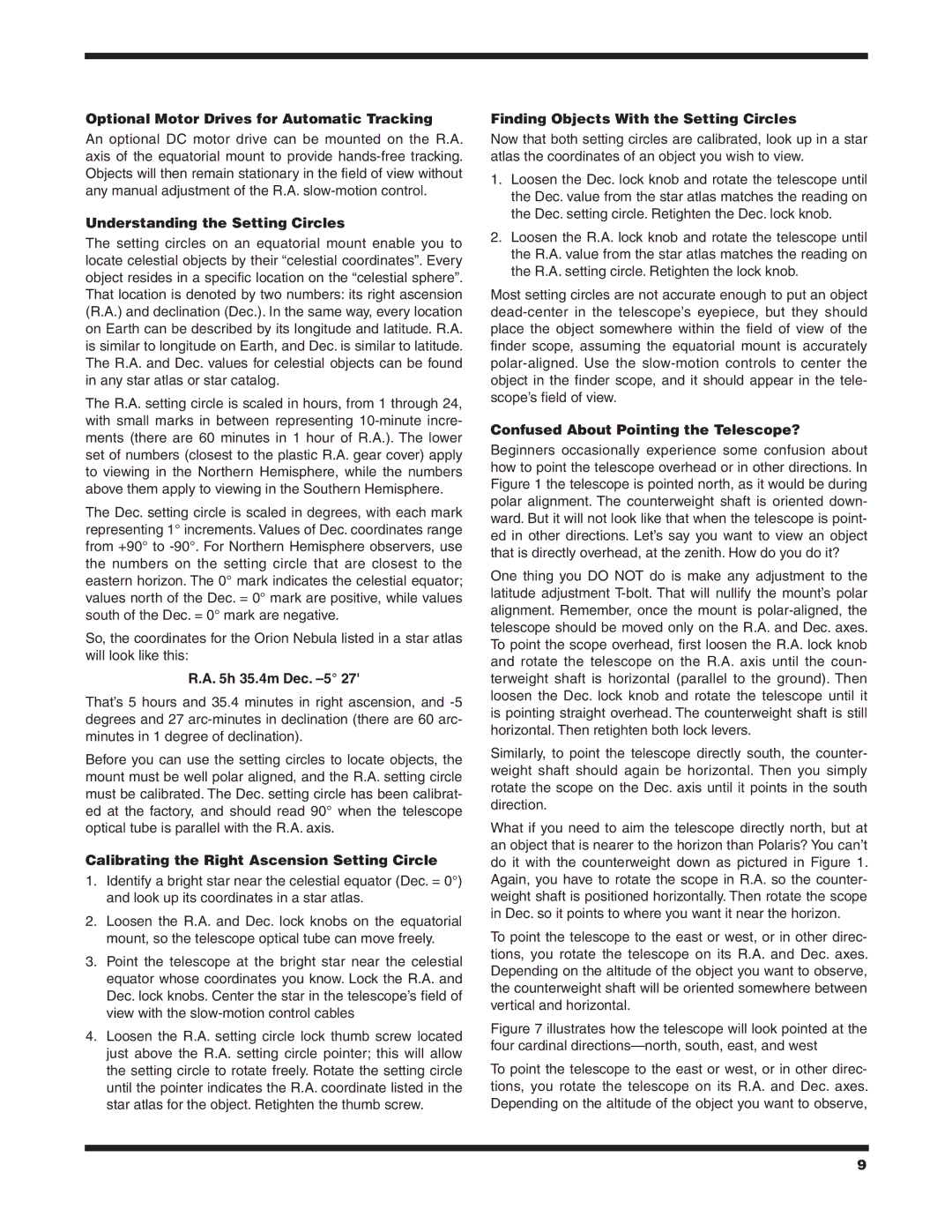
Optional Motor Drives for Automatic Tracking
An optional DC motor drive can be mounted on the R.A. axis of the equatorial mount to provide
Understanding the Setting Circles
The setting circles on an equatorial mount enable you to locate celestial objects by their “celestial coordinates”. Every object resides in a specific location on the “celestial sphere”. That location is denoted by two numbers: its right ascension (R.A.) and declination (Dec.). In the same way, every location on Earth can be described by its longitude and latitude. R.A. is similar to longitude on Earth, and Dec. is similar to latitude. The R.A. and Dec. values for celestial objects can be found in any star atlas or star catalog.
The R.A. setting circle is scaled in hours, from 1 through 24, with small marks in between representing
The Dec. setting circle is scaled in degrees, with each mark representing 1° increments. Values of Dec. coordinates range from +90° to
So, the coordinates for the Orion Nebula listed in a star atlas will look like this:
R.A. 5h 35.4m Dec. –5° 27'
That’s 5 hours and 35.4 minutes in right ascension, and
Before you can use the setting circles to locate objects, the mount must be well polar aligned, and the R.A. setting circle must be calibrated. The Dec. setting circle has been calibrat- ed at the factory, and should read 90° when the telescope optical tube is parallel with the R.A. axis.
Calibrating the Right Ascension Setting Circle
1.Identify a bright star near the celestial equator (Dec. = 0°) and look up its coordinates in a star atlas.
2.Loosen the R.A. and Dec. lock knobs on the equatorial mount, so the telescope optical tube can move freely.
3.Point the telescope at the bright star near the celestial equator whose coordinates you know. Lock the R.A. and Dec. lock knobs. Center the star in the telescope’s field of view with the
4.Loosen the R.A. setting circle lock thumb screw located just above the R.A. setting circle pointer; this will allow the setting circle to rotate freely. Rotate the setting circle until the pointer indicates the R.A. coordinate listed in the star atlas for the object. Retighten the thumb screw.
Finding Objects With the Setting Circles
Now that both setting circles are calibrated, look up in a star atlas the coordinates of an object you wish to view.
1.Loosen the Dec. lock knob and rotate the telescope until the Dec. value from the star atlas matches the reading on the Dec. setting circle. Retighten the Dec. lock knob.
2.Loosen the R.A. lock knob and rotate the telescope until the R.A. value from the star atlas matches the reading on the R.A. setting circle. Retighten the lock knob.
Most setting circles are not accurate enough to put an object
Confused About Pointing the Telescope?
Beginners occasionally experience some confusion about how to point the telescope overhead or in other directions. In Figure 1 the telescope is pointed north, as it would be during polar alignment. The counterweight shaft is oriented down- ward. But it will not look like that when the telescope is point- ed in other directions. Let’s say you want to view an object that is directly overhead, at the zenith. How do you do it?
One thing you DO NOT do is make any adjustment to the latitude adjustment
Similarly, to point the telescope directly south, the counter- weight shaft should again be horizontal. Then you simply rotate the scope on the Dec. axis until it points in the south direction.
What if you need to aim the telescope directly north, but at an object that is nearer to the horizon than Polaris? You can’t do it with the counterweight down as pictured in Figure 1. Again, you have to rotate the scope in R.A. so the counter- weight shaft is positioned horizontally. Then rotate the scope in Dec. so it points to where you want it near the horizon.
To point the telescope to the east or west, or in other direc- tions, you rotate the telescope on its R.A. and Dec. axes. Depending on the altitude of the object you want to observe, the counterweight shaft will be oriented somewhere between vertical and horizontal.
Figure 7 illustrates how the telescope will look pointed at the four cardinal directions—north, south, east, and west
To point the telescope to the east or west, or in other direc- tions, you rotate the telescope on its R.A. and Dec. axes. Depending on the altitude of the object you want to observe,
9
